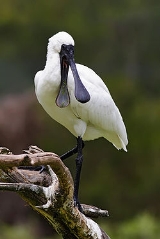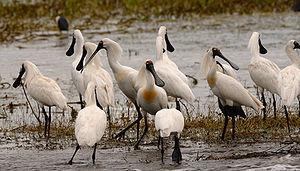
Royal Spoonbill
Encyclopedia
The Royal Spoonbill, Platalea regia, also known as the Black-billed Spoonbill, occurs in intertidal flats
and shallows of fresh and saltwater wetlands in Australia
, New Zealand
, Indonesia
, Papua New Guinea
, and the Solomon Islands
. It has also been recorded as a vagrant
in New Caledonia
. The Royal Spoonbill lives in wetlands and feeds on crustaceans, fish and small insects by sweeping its bill from side to side. It always flies with its head extended. Widespread throughout its large range, the Royal Spoonbill is evaluated as Least Concern
on the IUCN Red List
of Threatened Species.
first described the Royal Spoonbill in 1838, naming it Platalea regia and noting its similarity to the Eurasian Spoonbill (P. leucorodia). A 2010 study of mitochondrial DNA of the spoonbills by Chesser and colleagues found that the Royal and Black-faced Spoonbill
s were each others' closest relatives.
-spoonbill-2,-vic,-3.1.2008.jpg) The Royal Spoonbill is a large, white bird with a black, spoon-shaped bill. It is approximately 80 cm (31.5 in) tall, 74–81 cm (29.1–31.9 in) and a weight of 1.4–2.07 kg (3.1–4.6 lb). It is a wading bird and has long legs for walking through water. It eats fish
The Royal Spoonbill is a large, white bird with a black, spoon-shaped bill. It is approximately 80 cm (31.5 in) tall, 74–81 cm (29.1–31.9 in) and a weight of 1.4–2.07 kg (3.1–4.6 lb). It is a wading bird and has long legs for walking through water. It eats fish
, shellfish
, crabs and amphibians, catching its prey by making a side-to-side movement with its bill.
The end of the bill of the Royal Spoonbill is broader and works more like a pair of tongs
than the narrower bill of the Yellow-billed Spoonbill
, which acts like a forceps
.
Prey items recorded at Lake Cowal include freshwater crustaceans such as the common yabby
(Cherax destructor), shrmp of the genus Macrobrachium
and family Atyidae
, insects, particularly aquatic bugs of the families Notonectidae
and Corixidae, fish such as mosquitofish (Gambusia affinis) and goldfish (Carassius auratus), and oocasionally freshwater snails and plant material such as medic burr (Medicago polymorpha
).

Mudflat
Mudflats or mud flats, also known as tidal flats, are coastal wetlands that form when mud is deposited by tides or rivers. They are found in sheltered areas such as bays, bayous, lagoons, and estuaries. Mudflats may be viewed geologically as exposed layers of bay mud, resulting from deposition of...
and shallows of fresh and saltwater wetlands in Australia
Australia
Australia , officially the Commonwealth of Australia, is a country in the Southern Hemisphere comprising the mainland of the Australian continent, the island of Tasmania, and numerous smaller islands in the Indian and Pacific Oceans. It is the world's sixth-largest country by total area...
, New Zealand
New Zealand
New Zealand is an island country in the south-western Pacific Ocean comprising two main landmasses and numerous smaller islands. The country is situated some east of Australia across the Tasman Sea, and roughly south of the Pacific island nations of New Caledonia, Fiji, and Tonga...
, Indonesia
Indonesia
Indonesia , officially the Republic of Indonesia , is a country in Southeast Asia and Oceania. Indonesia is an archipelago comprising approximately 13,000 islands. It has 33 provinces with over 238 million people, and is the world's fourth most populous country. Indonesia is a republic, with an...
, Papua New Guinea
Papua New Guinea
Papua New Guinea , officially the Independent State of Papua New Guinea, is a country in Oceania, occupying the eastern half of the island of New Guinea and numerous offshore islands...
, and the Solomon Islands
Solomon Islands
Solomon Islands is a sovereign state in Oceania, east of Papua New Guinea, consisting of nearly one thousand islands. It covers a land mass of . The capital, Honiara, is located on the island of Guadalcanal...
. It has also been recorded as a vagrant
Vagrancy (biology)
Vagrancy is a phenomenon in biology whereby individual animals appear well outside their normal range; individual animals which exhibit vagrancy are known as vagrants. The term accidental is sometimes also used...
in New Caledonia
New Caledonia
New Caledonia is a special collectivity of France located in the southwest Pacific Ocean, east of Australia and about from Metropolitan France. The archipelago, part of the Melanesia subregion, includes the main island of Grande Terre, the Loyalty Islands, the Belep archipelago, the Isle of...
. The Royal Spoonbill lives in wetlands and feeds on crustaceans, fish and small insects by sweeping its bill from side to side. It always flies with its head extended. Widespread throughout its large range, the Royal Spoonbill is evaluated as Least Concern
Least Concern
Least Concern is an IUCN category assigned to extant taxon or lower taxa which have been evaluated but do not qualify for any other category. As such they do not qualify as threatened, Near Threatened, or Conservation Dependent...
on the IUCN Red List
IUCN Red List
The IUCN Red List of Threatened Species , founded in 1963, is the world's most comprehensive inventory of the global conservation status of biological species. The International Union for Conservation of Nature is the world's main authority on the conservation status of species...
of Threatened Species.
Taxonomy
The renowned ornithologist John GouldJohn Gould
John Gould was an English ornithologist and bird artist. The Gould League in Australia was named after him. His identification of the birds now nicknamed "Darwin's finches" played a role in the inception of Darwin's theory of evolution by natural selection...
first described the Royal Spoonbill in 1838, naming it Platalea regia and noting its similarity to the Eurasian Spoonbill (P. leucorodia). A 2010 study of mitochondrial DNA of the spoonbills by Chesser and colleagues found that the Royal and Black-faced Spoonbill
Black-faced Spoonbill
The Black-faced Spoonbill has the most restricted distribution of all spoonbills, and it is the only one currently regarded as endangered. Confined to the coastal areas of eastern Asia, it seems that it was once common throughout its area of distribution...
s were each others' closest relatives.
Description
-spoonbill-2,-vic,-3.1.2008.jpg)
Fish
Fish are a paraphyletic group of organisms that consist of all gill-bearing aquatic vertebrate animals that lack limbs with digits. Included in this definition are the living hagfish, lampreys, and cartilaginous and bony fish, as well as various extinct related groups...
, shellfish
Shellfish
Shellfish is a culinary and fisheries term for exoskeleton-bearing aquatic invertebrates used as food, including various species of molluscs, crustaceans, and echinoderms. Although most kinds of shellfish are harvested from saltwater environments, some kinds are found only in freshwater...
, crabs and amphibians, catching its prey by making a side-to-side movement with its bill.
The end of the bill of the Royal Spoonbill is broader and works more like a pair of tongs
Tongs
Tongs are used for gripping and lifting tools, of which there are many forms adapted to their specific use. Some are merely large pincers or nippers, but the greatest number fall into three classes:...
than the narrower bill of the Yellow-billed Spoonbill
Yellow-billed Spoonbill
The Yellow-billed Spoonbill is common in southeast Australia; it is not unusual on the remainder of the continent, and is a vagrant to New Zealand, Lord Howe Island and Norfolk Island. It is around 90 cm long, and has white plumage with a yellow bill, legs and feet. It nests in trees, marshes or...
, which acts like a forceps
Forceps
Forceps or forcipes are a handheld, hinged instrument used for grasping and holding objects. Forceps are used when fingers are too large to grasp small objects or when many objects need to be held at one time while the hands are used to perform a task. The term 'forceps' is used almost exclusively...
.
Feeding
The Royal Spoonbill is carnivorous, catching small animals by sweeping its bill through shallow water and swallowing prey once detected. When slow sweeping, the spoonbill walks slowly with the bill perpendicular to the water surface (i.e. vertical) with the bill tip open about 2 to 4 cm (0.8-1.6 in), sweeping an arc of around 100 degrees in front of the bird. The bird walks slowly, kicking up debris and small animals from the bottom of the body of water, which it senses and catches with its bill. When an item is sensed, the spoonbill switches to intensive sweeping of a small area. Royal Spoonbills also probe submerged plants directly for prey, and seize prey such as spiders above ground. They have also been observed dragging their bills through shallow water alongside them while walking.Prey items recorded at Lake Cowal include freshwater crustaceans such as the common yabby
Common yabby
The common yabby, Cherax destructor, is an Australian freshwater crustacean in the Parastacidae family. It is listed as a vulnerable species of crayfish by the World Conservation Union , though the validity of this listing is questionable; wild yabby populations remain strong, and have expanded...
(Cherax destructor), shrmp of the genus Macrobrachium
Macrobrachium
Macrobrachium is a genus of freshwater shrimp characterised by the extreme enlargement of the second pair of pereiopods, at least in the male...
and family Atyidae
Atyidae
Atyidae is a family of shrimp, present in all tropical and most temperate waters of the world. Adults of this family are almost always confined to fresh water...
, insects, particularly aquatic bugs of the families Notonectidae
Notonectidae
Notonectidae is a cosmopolitan family of aquatic insects in the order Hemiptera, commonly called backswimmers because they swim upside down. They are all predators, up to nearly 2 cm in size. They are similar in appearance to Corixidae , but can be separated by differences in their...
and Corixidae, fish such as mosquitofish (Gambusia affinis) and goldfish (Carassius auratus), and oocasionally freshwater snails and plant material such as medic burr (Medicago polymorpha
Medicago polymorpha
Medicago polymorpha is a plant species of the genus Medicago. It is native to the Mediterranean basin but is found throughout the world. It forms a symbiotic relationship with the bacterium Sinorhizobium medicae, which is capable of nitrogen fixation...
).
Breeding
When they are breeding, long white plumes grow from the back of their heads and coloured patches appear on the face. The nest is an open platform of sticks in a tree in which the female lays two or three eggs. The chicks hatch after 21 days. The birds are highly sensitive to disturbance in the breeding season. In Australia, whole colonies have been known to desert their eggs after a minor upset.

